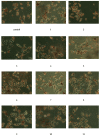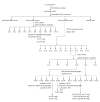Ten New Dammarane-Type Saponins with Hypolipidemia Activity from a Functional Herbal Tea- Gynostemma pentaphyllum
- PMID: 32824271
- PMCID: PMC7464191
- DOI: 10.3390/molecules25163737
Ten New Dammarane-Type Saponins with Hypolipidemia Activity from a Functional Herbal Tea- Gynostemma pentaphyllum
Abstract
Gynostemma pentaphyllum (thumb.) Makino is a functional herbal tea commonly used in Asian countries and regions to reduce blood lipid levels. G. pentaphyllum saponin is the main component, but there are still a large number of components with lipid-lowering activity that have not been found. In this study, 10 novel dammarane-type saponins, (1-10) and a known one (11) were isolated from G. pentaphyllum. Ten new compounds were identified and named as yunnangypenosides A-J (1-10), and another known one (11) was also obtained. Their chemical structures were determined by MS, NMR spectroscopic analyses. Moreover, the cytotoxicities on human HepG-2 hepatocellular carcinoma cells of these isolates were evaluated, and the results showed that compounds 1-11 had no obvious cytotoxicity. Finally, all these compounds were evaluated for their lipid-lowering effect by means of the oil red O staining method. Ten compounds could significantly reduce lipid levels except of 2, especially 8 exhibite the strongest hypolipidemia activity.
Keywords: Gynostemma pentaphyllum; chemical constituents; dammarane-type saponins; isolation and identification; lipid lowering effect.
Conflict of interest statement
The authors declare no conflicts of interest.
Figures





References
-
- Gou S., Liu B., Han X., Wang L., Zhong C., Liang S., Liu H., Qiang Y., Zhang Y., Ni J.M. Anti-atherosclerotic effect of Fermentum Rubrum and Gynostemma pentaphyllum mixture in high-fat emulsion- and vitamin D3-induced atherosclerotic rats. J. Chin. Med. Assoc. 2018;81:398–408. doi: 10.1016/j.jcma.2017.08.018. - DOI - PubMed
-
- Wei J., Zhang Y., Li D., Xie T., Li Y., Li J., Chen X., Wei G. Integrating network pharmacology and component analysis study on anti-atherosclerotic mechanisms of total flavonoids of Engelhardia roxburghiana leaves in mice. Chem. Biodivers. 2020;17:e1900629. doi: 10.1002/cbdv.201900629. - DOI - PubMed
MeSH terms
Substances
LinkOut - more resources
Full Text Sources
Medical

